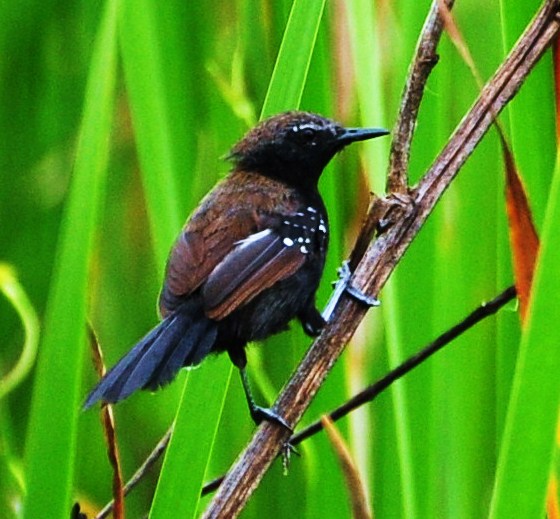Stymphalornis acutirostris
 |
| Photo by Dario Sanches (Flickr) |
Common name:
Paraná antwren (en); bicudinho-do-brejo (pt); grisin des marais (fr); hormiguerito del Paraná (es); schilfrohr-ameisenfänger (de)
Taxonomy:
Order Passeriformes
Family Thamnophilidae
Range:
This species is endemic to Brazil, only being found in coastal areas of the south-eastern states of Paraná, Santa Catarina and São Paulo.
Size:
The Paraná antwren is 15 cm long and weighs 8,5-11,5 g.
Habitat:
They are mostly found in littoral marshes dominated by Scirpus californicus, with other marsh vegetation such as grasses and bushes. They also occur in riverine marshes, flooded plains with herbaceous vegetation and transition areas to mangrove swamps and flooded lowland forests with herbaceous strata.
Diet:
The Paraná antwren forages in the lower herbaceous strata, mostly taking spiders, butterflies, crickets, flies and, occasionally, arboreal crabs.
Breeding:
These birds breed in August-February. They build a cup-shapes nest using plant fibres, leaves and stems, usually placed on reeds. There the female lays 2 white eggs with brown spots, which are incubated by both parents for 15-17 days. The chicks are fed by both parents and fledge 10-12 days after hatching, but may continue to receive food for up to 2 months.
Conservation:
IUCN status – EN (Endangered)
This species has a very small and fragmented breeding range, and the global population is estimated at just 10.000-20.000 individuals. The population is suspected to be facing a slow and ongoing population decline, owing to habitat loss and degradation. Some patches of habitat are under constant human pressure and have been reduced by fires, allotments and landfills. Other threats include land acquisition, disturbance from boat traffic on rivers during the breeding season, erosion due to water traffic, sand extraction from river margins, invasive vegetation and cattle-grazing. This species could also be affected by sea level rise, which could greatly reduce the area of suitable habitat







